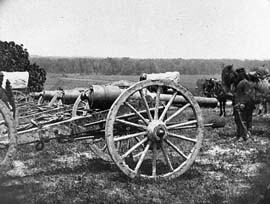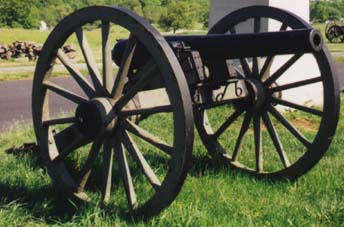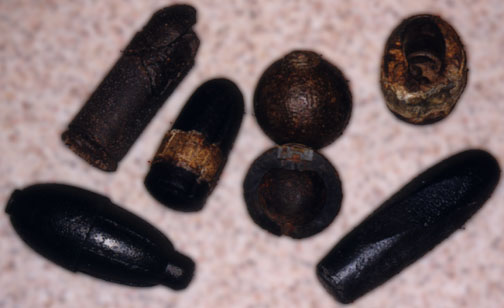
 At
full strength a standard Field Artillery battery consisted of six guns.
Horses pulled the guns. When horses ran short, mules could be used instead.
If the horses were killed in battle, guns could not be moved from the field
if threatened by the enemy. A battery had five officers: one captain commanding,
one lieutenant in charge of the caissons, and one lieutenant in charge
of the sections.
At
full strength a standard Field Artillery battery consisted of six guns.
Horses pulled the guns. When horses ran short, mules could be used instead.
If the horses were killed in battle, guns could not be moved from the field
if threatened by the enemy. A battery had five officers: one captain commanding,
one lieutenant in charge of the caissons, and one lieutenant in charge
of the sections. The Army Ordnance Board did some research into rifled guns because of the
accuracy, and the fact that the bores of bronze guns could be shot out
in as few as five hundred rounds. They settled on a design based on a design
that had been patented by John Griffen in 1855. The gun would be made of
wrought iron with a bore of three inches. Stripes of wrought iron would
be laid on a mandrel. They were then welded into one piece and machined
to the final contour.
The Army Ordnance Board did some research into rifled guns because of the
accuracy, and the fact that the bores of bronze guns could be shot out
in as few as five hundred rounds. They settled on a design based on a design
that had been patented by John Griffen in 1855. The gun would be made of
wrought iron with a bore of three inches. Stripes of wrought iron would
be laid on a mandrel. They were then welded into one piece and machined
to the final contour.Both smoothbore and rifled guns could shoot the same type of ammunition. They could shoot solid, shell, case, and canister (or grape).
 Solid shot rifles were used to batter fortifications. At a later time smoothbores
became superior because the ball could be skipped across the battlefield.
This in turn would cause more casualties over a large area of the field.
An officer at Gettysburg is said to have said that he observed a ball bouncing
around in the rear. He then stuck his foot out to stop the ball. He later
had his foot removed because of it. Shell was a hollow projectile and was
filled with gunpowder. A fuse exploded them. Case shot was another hollow
projectile but with thinner walls than the common shell. They were filled
with a bursting charge. They were also filled with smaller balls. The shot
was exploded by a time fuse. They did so that the shot and the shell would
“fly” to the target. Canister was a cylinder that was packed with balls
in sawdust. When the gun was fired, the cylinder disintegrated and the
balls would fan out. All in all, during the Civil War the weaponry took
a drastic turn. Some invented new guns while others perfected other guns.
Some even found new guns by accident. The Civil War also produced many
new guns by the end of the war.Some new guns were the first metallic rifle,pistol
cartridges,and reapeting rifles.
Solid shot rifles were used to batter fortifications. At a later time smoothbores
became superior because the ball could be skipped across the battlefield.
This in turn would cause more casualties over a large area of the field.
An officer at Gettysburg is said to have said that he observed a ball bouncing
around in the rear. He then stuck his foot out to stop the ball. He later
had his foot removed because of it. Shell was a hollow projectile and was
filled with gunpowder. A fuse exploded them. Case shot was another hollow
projectile but with thinner walls than the common shell. They were filled
with a bursting charge. They were also filled with smaller balls. The shot
was exploded by a time fuse. They did so that the shot and the shell would
“fly” to the target. Canister was a cylinder that was packed with balls
in sawdust. When the gun was fired, the cylinder disintegrated and the
balls would fan out. All in all, during the Civil War the weaponry took
a drastic turn. Some invented new guns while others perfected other guns.
Some even found new guns by accident. The Civil War also produced many
new guns by the end of the war.Some new guns were the first metallic rifle,pistol
cartridges,and reapeting rifles.